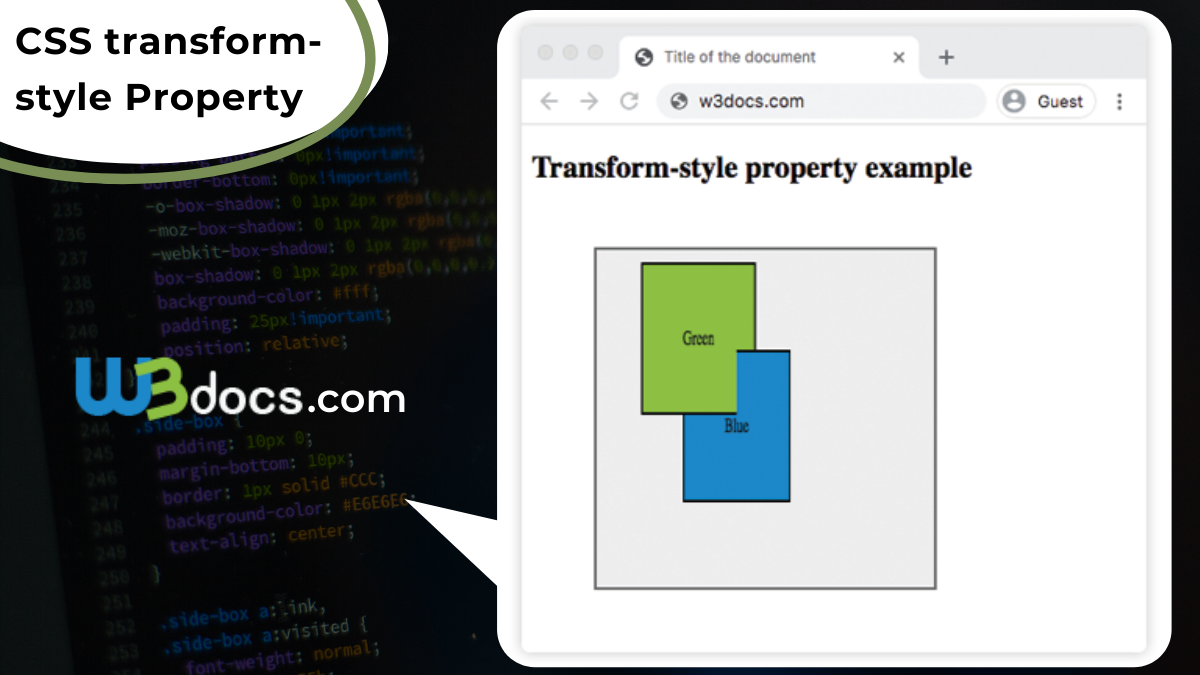
By moving the element back leftwards and upwards by half of its width and height respectively, you sure that its center now aligns with the parent's center, making it visually horizontally + vertically centered. Remember than when you set left: 50% top 50% on the element, you are moving its top left corner to the center of its parent (which means it is not visually centered at all). The text-transform property is used to specify uppercase and lowercase letters in a text. This effectively moves the center of the element to its original top left corner. O W3C descreve CSS Transform assim: CSS 2D Transforms allow elements rendered by CSS to be trans- formed in two-dimensional space. To better understand the transform-style property, view a demo. Note: This property must be used together with the transform property. move me upwards by 50% of my height, along the y-axis The transform-style property specifies how nested elements are rendered in 3D space.move me leftwards by 50% of my width, along the x-axis, and.In simple terms, it can be boiled down to translateX(-50%) translateY(-50%), which means: The reason why transform: translate(-50%, -50%) is required is because you want the center of the element to line up with the center of its parent. Add the following to the CSS section of your page. Within a CSS block, you must supply not only the standard syntax version, but also alternative declarations tailored to the various browsers. We talked a little bit about vendor prefixes when discussing drop shadows for transforms, we need even more vendor prefixes (joy!). Looks fairly straightforward, however, at the moment the reality of using CSS3 transforms is a little more complex. First we specify that the declaration is a transform, then we indicate the type of transform, in this case translate, along with parameter values indicating the amount of distance we want to translate the element. The axis of rotation passes by the origin, defined by transform-origin CSS property. The amount of movement is defined by the specified angle if positive, the movement will be clockwise, if negative, it will be counter-clockwise. This indicates a translation of 100 pixels to the right along the X axis and 200 down the Y axis. The rotateY () CSS function defines a transformation that moves the element around the ordinate without deforming it. This is the basic syntax: transform: translate(100px, 200px) The translate transform moves an element along the X and Y axes by a specified amount in each direction. Translate (Move) the Pictureįirst let's use the translate transform to move the element. It's advisable to only implement the transforms as an optional extra design feature. However, this still leaves a substantial portion of your potential users whose browsers will not support the transforms, so it's best not to use designs that are reliant on them. In general, the CSS3 transform property is supported by all of the recent versions of each major browser, including Internet Explorer 9, Firefox 3.5, Chrome 4.0, Safari 3.1 and Opera 10.5.
We will explore a variety of transform options. Using transform, elements can be translated, rotated and/or scaled in two or three dimensional space. Alter the source attribute ( src="nice_picture.jpg") to reflect the name and location of your own image if you have one you want to use. The transform property allows you to visually transform an element in two-dimensional or three-dimensional space. Values of the CSS transform property are functions that transform the target element, including translate(), scale(), and rotate(). We will use the class attribute to identify the image in CSS. The CSS transform property changes the shape, position, and orientation of page elements. We will use an image element to demonstrate the CSS3 transforms, so add one to the body section of your page as follows: Prepare an HTML5 page outline using the following sample markup:

There's a demo at the end of the article that incorporates all of these effects you might want to open it now.
CSS TRANSFORM FULL
In this article, we'll touch on the full gamut of possibilities and limitations. Although it is tempting to jump in and start maximizing on these effects, it is essential to be aware of the many browser compatibility issues that still remain, making sure you take care of all users who access your site, regardless of which browser they are using. CSS3 transforms allow you to manipulate visual page elements, moving, scaling, rotating and skewing them.

CSS TRANSFORM CODE
With HTML5 and CSS3, you can implement relatively sophisticated graphic effects natively within your web page code – no plugins or static images needed. With the advent of CSS3, web design is beginning to benefit from a significantly improved range of styling options. Using CSS3 Transforms to Manipulate Page Elements


 0 kommentar(er)
0 kommentar(er)
